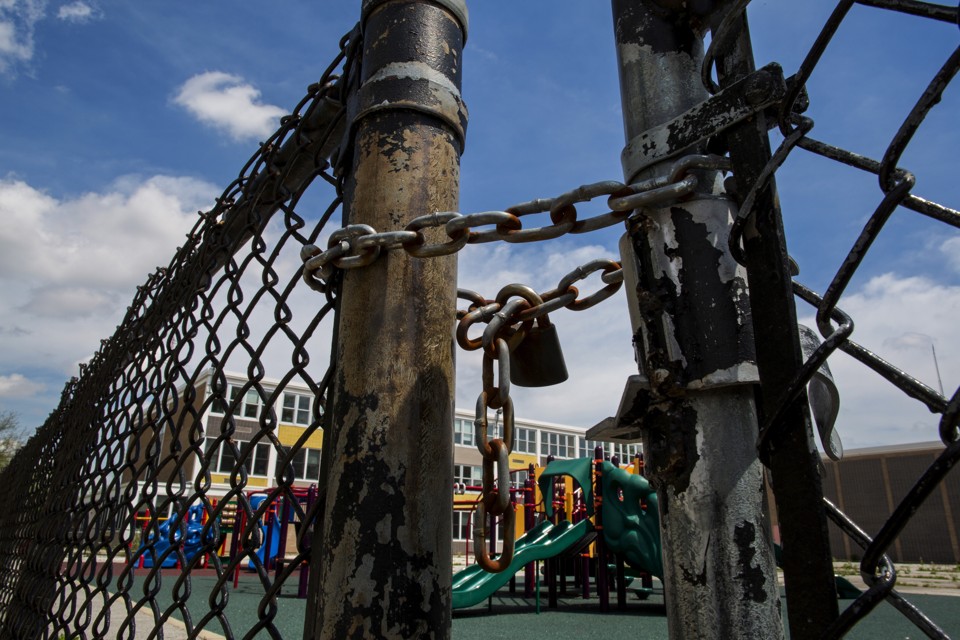Chicago's Inescapable Segregation
The racial separation that permeates nearly every aspect of life in the Windy City is inexcusable.

Woods Elementary Math & Science Academy, located on Chicago's Woods Elementary Math & Science Academy, located on Chicago's South Side, is permanently closedSouth Side, is permanently closed
Chicago is a city with a rich black heritage. And the South Side, fondly dubbed the “heart of black America,” is where much of the city’s cherished history emanates. Comprising a mix of poverty-stricken, working-class, and upper-income black residents, the South Side can lay claim to the country’s first black woman senator, the nation’s first black president, and various black elites. Chicago also holds theinglorious distinction of being one of the country’s most segregated cities. This is also the South Side’s legacy—and it encompasses its public schools.
With the return of Chicago public-school students to school just two weeks away, nearly 1,000 teachers and support staff received layoff notices earlier this month. Among the schools hardest hit: the South Side’s Bradwell School of Excellence and Harlan Community Academy, an elementary school and high school, respectively, with staff cuts in the double digits. The most recent layoffs continue an alarming pattern of racial inequality that was documented following Chicago’s mass school closings in 2013. As reported by The American Prospect, “While black students were 40 percent of Chicago’s school district population … they made up 88 percent of those affected by the [public-school] closures.”
The stain of segregation bleeds into the most basic elements of black lives—fromhousing and health to food equality and educational opportunity—and no area exemplifies this like the neighborhoods that make up the South Side of Chicago. Natalie Y. Moore, a South Side native and public-radio journalist who covers the region, explores the systems and sentiments that keep Chicago segregation intact in The South Side: A Portrait of Chicago and American Segregation, a newly published combination of personal memoir and historical narrative. She recently shared some thoughts and reflections on her hometown. The interview that follows has been lightly edited for brevity and clarity.
With the return of Chicago public-school students to school just two weeks away, nearly 1,000 teachers and support staff received layoff notices earlier this month. Among the schools hardest hit: the South Side’s Bradwell School of Excellence and Harlan Community Academy, an elementary school and high school, respectively, with staff cuts in the double digits. The most recent layoffs continue an alarming pattern of racial inequality that was documented following Chicago’s mass school closings in 2013. As reported by The American Prospect, “While black students were 40 percent of Chicago’s school district population … they made up 88 percent of those affected by the [public-school] closures.”
The stain of segregation bleeds into the most basic elements of black lives—fromhousing and health to food equality and educational opportunity—and no area exemplifies this like the neighborhoods that make up the South Side of Chicago. Natalie Y. Moore, a South Side native and public-radio journalist who covers the region, explores the systems and sentiments that keep Chicago segregation intact in The South Side: A Portrait of Chicago and American Segregation, a newly published combination of personal memoir and historical narrative. She recently shared some thoughts and reflections on her hometown. The interview that follows has been lightly edited for brevity and clarity.
Melinda D. Anderson: In Beverly, a South-Side neighborhood of Chicago, something remarkable was nurtured and grown: The community stands out for its ability to counter white flight in the 1970s and today remains a racially diverse area with some integrated schools—a glaring anomaly in the city of Chicago. Are there lessons to be gleaned from how this community has maintained its racial and ethnic diversity?
Natalie Y. Moore: Integration has to be deliberate and intentional. It doesn’t always just happen or maintain itself. One of the culprits [in advancing] integration has historically been the real-estate industry, which encouraged blockbusting and panic peddling. In the 1970s, Beverly leaders fought back through lawsuits and organizing, such as banning for-sale lawn signs in front of Segregation Permeates Chicago's South Side, But Change Is Possible - The Atlantic:
Natalie Y. Moore: Integration has to be deliberate and intentional. It doesn’t always just happen or maintain itself. One of the culprits [in advancing] integration has historically been the real-estate industry, which encouraged blockbusting and panic peddling. In the 1970s, Beverly leaders fought back through lawsuits and organizing, such as banning for-sale lawn signs in front of Segregation Permeates Chicago's South Side, But Change Is Possible - The Atlantic:
